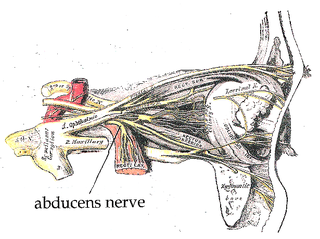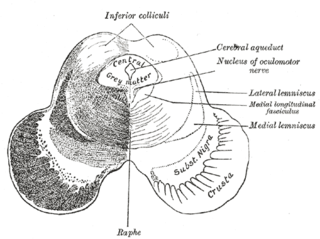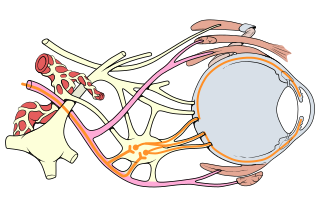Related Research Articles

Inflammation of the geniculate ganglion of the facial nerve is a late consequence of varicella zoster virus (VZV) known as Ramsay Hunt syndrome (RHS), commonly known as herpes zoster oticus. In regard to the frequency, less than 1% of varicella zoster infections involve the facial nerve and result in RHS. It is traditionally defined as a triad of ipsilateral facial paralysis, otalgia, and vesicles close to the ear and auditory canal. Due to its proximity to the vestibulocochlear nerve, the virus can spread and cause hearing loss, tinnitus (hearing noises that are not caused by outside sounds), and vertigo. It is common for diagnoses to be overlooked or delayed, which can raise the likelihood of long-term consequences. It is more complicated than Bell's palsy. Therapy aims to shorten its overall length, while also providing pain relief and averting any consequences.

Cranial nerves are the nerves that emerge directly from the brain, of which there are conventionally considered twelve pairs. Cranial nerves relay information between the brain and parts of the body, primarily to and from regions of the head and neck, including the special senses of vision, taste, smell, and hearing.

Bell's palsy is a type of facial paralysis that results in a temporary inability to control the facial muscles on the affected side of the face. In most cases, the weakness is temporary and significantly improves over weeks. Symptoms can vary from mild to severe. They may include muscle twitching, weakness, or total loss of the ability to move one or, in rare cases, both sides of the face. Other symptoms include drooping of the eyebrow, a change in taste, and pain around the ear. Typically symptoms come on over 48 hours. Bell's palsy can trigger an increased sensitivity to sound known as hyperacusis.

The abducens nerve or abducent nerve, also known as the sixth cranial nerve, cranial nerve VI, or simply CN VI, is a cranial nerve in humans and various other animals that controls the movement of the lateral rectus muscle, one of the extraocular muscles responsible for outward gaze. It is a somatic efferent nerve.

The facial nerve, also known as the seventh cranial nerve, cranial nerve VII, or simply CN VII, is a cranial nerve that emerges from the pons of the brainstem, controls the muscles of facial expression, and functions in the conveyance of taste sensations from the anterior two-thirds of the tongue. The nerve typically travels from the pons through the facial canal in the temporal bone and exits the skull at the stylomastoid foramen. It arises from the brainstem from an area posterior to the cranial nerve VI and anterior to cranial nerve VIII.

The oculomotor nerve, also known as the third cranial nerve, cranial nerve III, or simply CN III, is a cranial nerve that enters the orbit through the superior orbital fissure and innervates extraocular muscles that enable most movements of the eye and that raise the eyelid. The nerve also contains fibers that innervate the intrinsic eye muscles that enable pupillary constriction and accommodation. The oculomotor nerve is derived from the basal plate of the embryonic midbrain. Cranial nerves IV and VI also participate in control of eye movement.

The pyramidal tracts include both the corticobulbar tract and the corticospinal tract. These are aggregations of efferent nerve fibers from the upper motor neurons that travel from the cerebral cortex and terminate either in the brainstem (corticobulbar) or spinal cord (corticospinal) and are involved in the control of motor functions of the body.

The medial longitudinal fasciculus (MLF) is an area of crossed over tracts, on each side of the brainstem. These bundles of axons are situated near the midline of the brainstem. They are made up of both ascending and descending fibers that arise from a number of sources and terminate in different areas, including the superior colliculus, the vestibular nuclei, and the cerebellum. It contains the interstitial nucleus of Cajal, responsible for oculomotor control, head posture, and vertical eye movement.

The lateral rectus muscle is a muscle on the lateral side of the eye in the orbit. It is one of six extraocular muscles that control the movements of the eye. The lateral rectus muscle is responsible for lateral movement of the eyeball, specifically abduction. Abduction describes the movement of the eye away from the midline, allowing the eyeball to move horizontally in the lateral direction, bringing the pupil away from the midline of the body.

The abducens nucleus is the originating nucleus from which the abducens nerve (VI) emerges—a cranial nerve nucleus. This nucleus is located beneath the fourth ventricle in the caudal portion of the pons near the midline, medial to the sulcus limitans.

The ciliary ganglion is a bundle of nerves, parasympathetic ganglion located just behind the eye in the posterior orbit. It is 1–2 mm in diameter and in humans contains approximately 2,500 neurons. The ganglion contains postganglionic parasympathetic neurons. These neurons supply the pupillary sphincter muscle, which constricts the pupil, and the ciliary muscle which contracts to make the lens more convex. Both of these muscles are involuntary since they are controlled by the parasympathetic division of the autonomic nervous system.

Sixth nerve palsy, or abducens nerve palsy, is a disorder associated with dysfunction of cranial nerve VI, which is responsible for causing contraction of the lateral rectus muscle to abduct the eye. The inability of an eye to turn outward, results in a convergent strabismus or esotropia of which the primary symptom is diplopia in which the two images appear side-by-side. Thus, the diplopia is horizontal and worse in the distance. Diplopia is also increased on looking to the affected side and is partly caused by overaction of the medial rectus on the unaffected side as it tries to provide the extra innervation to the affected lateral rectus. These two muscles are synergists or "yoke muscles" as both attempt to move the eye over to the left or right. The condition is commonly unilateral but can also occur bilaterally.

The facial motor nucleus is a collection of neurons in the brainstem that belong to the facial nerve. These lower motor neurons innervate the muscles of facial expression and the stapedius.

Fazio–Londe disease (FLD), also called progressive bulbar palsy of childhood, is a very rare inherited motor neuron disease of children and young adults and is characterized by progressive paralysis of muscles innervated by cranial nerves.

Marcus Gunn phenomenon is an autosomal dominant condition with incomplete penetrance, in which nursing infants will have rhythmic upward jerking of their upper eyelid. This condition is characterized as a synkinesis: when two or more muscles that are independently innervated have either simultaneous or coordinated movements.

Oculomotor nerve palsy or oculomotor neuropathy is an eye condition resulting from damage to the third cranial nerve or a branch thereof. As the name suggests, the oculomotor nerve supplies the majority of the muscles controlling eye movements. Damage to this nerve will result in an inability to move the eye normally. The nerve also supplies the upper eyelid muscle and is accompanied by parasympathetic fibers innervating the muscles responsible for pupil constriction. The limitations of eye movement resulting from the condition are generally so severe that patients are often unable to maintain normal eye alignment when gazing straight ahead, leading to strabismus and, as a consequence, double vision (diplopia).
The term gaze is frequently used in physiology to describe coordinated motion of the eyes and neck. The lateral gaze is controlled by the paramedian pontine reticular formation (PPRF). The vertical gaze is controlled by the rostral interstitial nucleus of medial longitudinal fasciculus and the interstitial nucleus of Cajal.

Cranial nerve disease is an impaired functioning of one of the twelve cranial nerves. Although it could theoretically be considered a mononeuropathy, it is not considered as such under MeSH.

Smile surgery or smile reconstruction is a surgical procedure that restores the smile for people with facial nerve paralysis. Facial nerve paralysis is a relatively common condition with a yearly incidence of 0.25% leading to function loss of the mimic muscles. The facial nerve gives off several branches in the face. If one or more facial nerve branches are paralysed, the corresponding mimetic muscles lose their ability to contract. This may lead to several symptoms such as incomplete eye closure with or without exposure keratitis, oral incompetence, poor articulation, dental caries, drooling, and a low self-esteem. This is because the different branches innervate the frontalis muscle, orbicularis oculi and oris muscles, lip elevators and depressors, and the platysma. The elevators of the upper lip and corner of the mouth are innervated by the zygomatic and buccal branches. When these branches are paralysed, there is an inability to create a symmetric smile.
Alternating hemiplegia is a form of hemiplegia that has an ipsilateral cranial nerve palsies and contralateral hemiplegia or hemiparesis of extremities of the body. The disorder is characterized by recurrent episodes of paralysis on one side of the body. There are multiple forms of alternating hemiplegia, Weber's syndrome, middle alternating hemiplegia, and inferior alternating hemiplegia. This type of syndrome can result from a unilateral lesion in the brainstem affecting both upper motor neurons and lower motor neurons. The muscles that would receive signals from these damaged upper motor neurons result in spastic paralysis. With a lesion in the brainstem, this affects the majority of limb and trunk muscles on the contralateral side due to the upper motor neurons decussation after the brainstem. The cranial nerves and cranial nerve nuclei are also located in the brainstem making them susceptible to damage from a brainstem lesion. Cranial nerves III (Oculomotor), VI (Abducens), and XII (Hypoglossal) are most often associated with this syndrome given their close proximity with the pyramidal tract, the location which upper motor neurons are in on their way to the spinal cord. Damages to these structures produce the ipsilateral presentation of paralysis or palsy due to the lack of cranial nerve decussation before innervating their target muscles. The paralysis may be brief or it may last for several days, many times the episodes will resolve after sleep. Some common symptoms of alternating hemiplegia are mental impairment, gait and balance difficulties, excessive sweating and changes in body temperature.
References
- 1 2 3 4 Congenital mirror movement disorder here April 2015 Genetics Home Reference, National Library of Medicine, accessed June 27, 2017
- 1 2 Beurskens CH, Heymans PG (2006). "Mime therapy improves facial symmetry in people with long-term facial nerve paresis: a randomised controlled trial". Aust J Physiother. 52 (3): 177–83. doi: 10.1016/s0004-9514(06)70026-5 . hdl: 2066/50541 . PMID 16942452.
- 1 2 3 4 Nakamura K, Toda N, Sakamaki K, Kashima K, Takeda N (2003). "Biofeedback rehabilitation for prevention of synkinesis after facial palsy". Otolaryngol Head Neck Surg . 128 (4): 539–43. doi:10.1016/S0194-5998(02)23254-4. PMID 12707658.
- ↑ Manikandan N. (2007). "Effect of facial neuromuscular re-education on facial symmetry in patients with Bell's palsy: a randomized controlled trial". Clin Rehabil. 21 (4): 338–43. doi:10.1177/0269215507070790. PMID 17613574. S2CID 7204264.
- 1 2 Mehta RP, WernickRobinson M, Hadlock TA (2007). "Validation of the Synkinesis Assessment Questionnaire". Laryngoscope. 117 (5): 923–6. doi:10.1097/MLG.0b013e3180412460. PMID 17473697. S2CID 5614795.
- 1 2 Montoya FJ, Riddell CE, Caesar R, Hague S (2002). "Treatment of gustatory hyperlacrimation (crocodile tears) with injection of botulinum toxin into the lacrimal gland". Eye. 16 (6): 705–09. doi: 10.1038/sj.eye.6700230 . PMID 12439663.
- 1 2 Buckley EG, Ellis FD, Postel E, Saunders T (2005). "Postraumatic Abducens to Oculomotor Nerve Misdirection". Journal of AAPOS. 9 (1): 12–16. doi:10.1016/j.jaapos.2004.11.011. PMID 15729274.
- ↑ Pfeiffer N, Simonsz HJ, Kommerell G (1992). "Misdirected regeneration of abducens nerve neurons into the parasympathetic pupillary pathway". Graefes Arch Clin Exp Ophthalmol. 230 (2): 150–3. doi:10.1007/BF00164653. PMID 1577295. S2CID 23622956.
- ↑ Kothari M, Hussain A, Kar D, Toshniwal S (2007). "Primary superior oblique muscle-levator muscle synkinesis". J AAPOS. 11 (2): 204–5. doi:10.1016/j.jaapos.2006.12.054. PMID 17416331.
- ↑ Raab, Edward (1982). "Etiologic Factors In Accommodative esodeviation". Transactions of the American Ophthalmological Society. 80: 657–694. PMC 1312281 . PMID 7182971.
- ↑ McGovern ST, Crompton JL, Ingham PN (1986). "Trigemino-abducens synkinesis: an unusual case of aberrant regeneration". Australian and New Zealand Journal of Ophthalmology. 14 (3): 275–9. doi: 10.1111/j.1442-9071.1986.tb00049.x . PMID 3768184.
- 1 2 Rubin DI, Matsumoto JY, Suarez GA, Auger RG (1999). "Facial trigeminal synkinesis associated with a trigeminal schwannoma". Neurology. 53 (3): 635–7. doi:10.1212/wnl.53.3.635. PMID 10449135. S2CID 42111741.
- 1 2 Moran CJ, Neely JG (1996). "Patterns of facial nerve synkinesis". Laryngoscope. 106 (12): 1491–6. doi:10.1097/00005537-199612000-00009. PMID 8948609. S2CID 25982319.
- ↑ Choi D, Raisman G (2004). "After facial nerve damage, regenerating axons become aberrant throughout the length of the nerve and not only at the site of the lesion: an experimental study". Br J Neurosurg. 18 (1): 45–8. doi:10.1080/02688690410001660454. PMID 15040714. S2CID 44465168.
- ↑ Sadjadpour K. (1975). "After Postfacial palsy phenomena: faulty nerve regeneration or ephaptic transmission?". Brain Res. 95 (2–3): 403–6. doi:10.1016/0006-8993(75)90117-1. PMID 168941. S2CID 41333187.
- ↑ Sibony PA, Lessell S, Gittinger JW Jr (1984). "Acquired oculomotor synkinesis". Surv. Ophthalmol. 28 (5): 382–90. doi:10.1016/0039-6257(84)90243-1. PMID 6372143.
- ↑ May, Mark; Barry M. Schaitkin (1999). The Facial Nerve. Thieme. p. 49. ISBN 0-86577-821-3.
- 1 2 Brach JS, VanSwearingen JM, Lenert J, Johnson PC (1997). "Facial neuromuscular retraining for oral synkinesis". Plast Reconstr Surg. 99 (7): 1922–31. doi:10.1097/00006534-199706000-00017. PMID 9180715. S2CID 44319856.
- ↑ Brudny J, Hammerschlag PE, Cohen NL, Ransohoff J (1988). "Electromyographic rehabilitation of facial function and introduction of a facial paralysis grading scale for hypoglossal-facial nerve anastomosis". Laryngoscope. 98 (4): 405–10. doi:10.1288/00005537-198804000-00010. PMID 3352440. S2CID 33729029.
- ↑ Ross B, Nedzelski JM, McLean JA (1991). "Efficacy of feedback training in long-standing facial nerve paresis". Laryngoscope. 101 (7): 744–50. doi:10.1288/00005537-199107000-00009. PMID 2062155. S2CID 44951069.
- ↑ Beurskens CH, Heymans PG (2003). "Positive effects of mime therapy on sequelae of facial paralysis: stiffness, lip mobility, and social and physical aspects of facial disability". Otol. Neurotol. 24 (4): 677–81. doi:10.1097/00129492-200307000-00024. PMID 12851564. S2CID 15792060.
- ↑ Beurskens CH, Heymans PG, Oostendorp RA (2006). "Stability of benefits of mime therapy in sequelae of facial nerve paresis during a 1-year period". Otol. Neurotol. 27 (7): 1037–42. doi:10.1097/01.mao.0000217350.09796.07. PMID 17006356. S2CID 11417071.
- ↑ de Maio M, Bento RF (2007). "Botulinum toxin in facial palsy: an effective treatment for contralateral hyperkinesis". Plast Reconstr Surg. 120 (4): 917–27. doi:10.1097/01.prs.0000244311.72941.9a. PMID 17805119. S2CID 42198102.
- ↑ D. Markey, Jeffrey (2017). "Latest advances in the management of facial synkinesis". Current Opinion in Otolaryngology & Head and Neck Surgery. 25 (4): 265–272. doi:10.1097/MOO.0000000000000376. PMID 28604403. S2CID 23341301.
- 1 2 3 Ito H, Ito H, Nakano S, Kusaka H (2007). "Low-dose subcutaneous injection of botulinum toxin type A for facial synkinesis and hyperlacrimation". Acta Neurol. Scand. 115 (4): 271–4. doi:10.1111/j.1600-0404.2006.00746.x. PMID 17376126. S2CID 20722812.
- ↑ May, Mark; Barry M. Schaitkin (1999). The Facial Nerve. Thieme. p. 467. ISBN 0-86577-821-3.